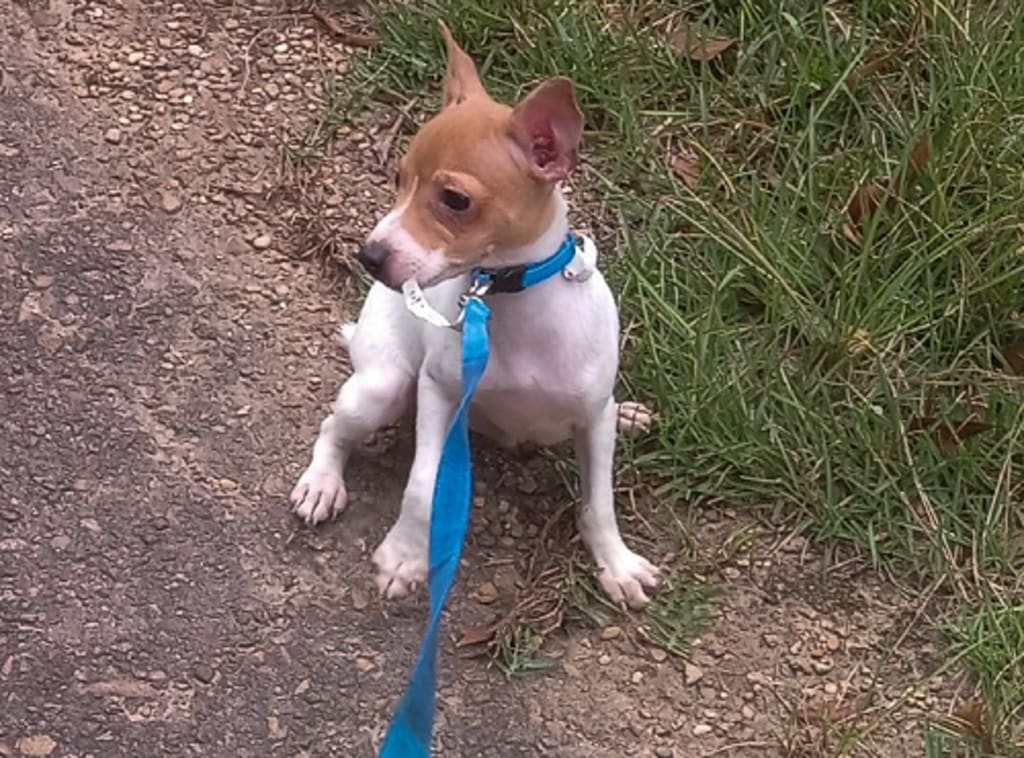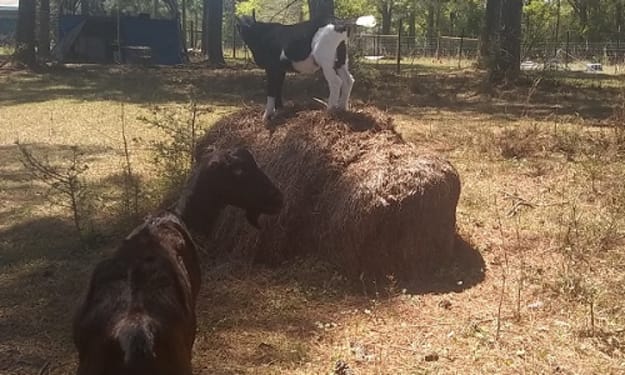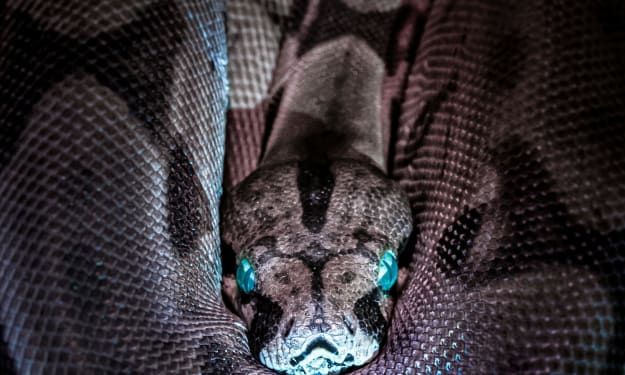Just What is a "Training Walk?"
And why would you do it?

Training walks are not part of every dog trainer's repertoire. In fact, I think that Yaddle and I made them up. The concept is very simple. You take your dog for a walk and train your dog during the walk. The more difficult aspect of the training walk is to make the training invisible to your dog or, if not invisible, fun. I started training walks for Yaddle, because of her stress and her brain injury, but any young, stressed, or anxious dog can benefit from them. Keep a training walk short, no more than 15 minutes or so to keep it fun and interesting. If you're planning to walk longer, incorporate your training walk into the longer walk.
Try to time your walk for when there will be no distractions. For me, the best time starts at mid-morning and ends in early afternoon. If I'm walking at the church down the road (they have a big parking lot and field--I have permission to train there), then the times are slightly different. You'll need to put your dog on a leash that is at least five feet long, preferably six feet, because you'll be doing things that ask your dog to be a short distance from you. Before you leave, fill your pocket with lots of soft treats that your dog can snap up in one bite. Then, hit the road. Or the sidewalk. Or whatever. Leave the clicker and the treat bag at home, if you use them. The training is invisible, remember?
Loose Leash Walking

If this is your dog's first time on the walk, he or she will be curious about the world. It's okay if they sniff, but don't let them lunge or pull. A cheerful "where's Widget?" combined with the lure of a treat will get most dogs back close to their trainer's side. If you care about getting them into heel position to set the foundation for formal training, you can gradually lure them there. If your dog is on your left side, putting the leash behind your legs and holding it in your right hand will prevent your dog from pulling ahead of you ("forging") while holding a treat in front of them will get them close to heel position. Walk on for a few steps, then bring the leash back around and make a fuss over the dog. Walks? Cookies? Lovies? What family dog, especially a puppy, wouldn't love this kind of training? Keep your first few walks short and the loose leash training confined to four or five steps at a time.
Beginning Recall
Once your dog is walking on a loose leash, sometimes even during your first walk, you can start training the "recall," also known as the "come" command. Remember, light and fun is the key. Walk briskly on for a few paces and let your dog out on the leash ever so slightly. As your dog passes you, let out more slack in your leash and use whatever command you'll be using for your dog to come to you.
As your dog is going forward, take a couple of small steps backward. Call out, "Widget, come!" or whatever your command of choice will be, in a light and happy tone. DON'T reel your dog in. He or she should come to you, just to be with you. Have your treat ready. If your dog runs right to you, give the treat and make a fuss, but just keep walking. S/he'll swing in right next to you and will be waiting for the next time you call. If your dog DOESN'T come, don't worry. The command is meaningless at this point and your dog doesn't know that not responding is disobedience. Just hold on to the treat and keep walking. Try again, after asking your dog to walk quietly next to you, to give him/her a success that will result in a treat.
Once your dog is coming to you at a brisk pace and waiting for that treat, you can start having him or her sit in front of you as part of the exercise. Sitting at the return prevents jumping up--another training task completed without your dog knowing it!
Adjusting Your Pace
Someday, you'll want to walk your dog in a public place, when other people are around. For me, that means taking them to dog shows. If you've ever been to a dog show during the class competitions, you know that means walking through crowded spaces, around a lot of people and dogs, and speeding up or slowing down at a second's notice.
You can do that on your training walks, too, even if you're by you and your dog are by yourselves. If you're not doing so already, talk to your dog to get his or her attention. Start meandering for about five or six steps, then gradually speed up to your normal pace. Your dog may lag behind you for a bit, taking advantage of the slow pace to sniff at things or to look around. You can lower a treat to the side of your leg, letting your dog sniff it, to keep him or her right next to you. Do the same for a dog that forges ahead when you pick up the pace into a "fast" speed. Your dog should adjust his or her pace to yours, not the other way around. It's okay if the dog bounces a little bit to stay next to you and get the treat. Self-control develops as your dog comes to realize that the treat will always be given and that good behavior is the quickest way to get it.
Have a Little Fun!
Like anyone else, dogs like changing up their routines sometimes. Instead of just sitting, recalling, and maybe practicing their stay at curbs, what else can be done? One thing I like to do is prepare dogs for their basic Rally signs. Your neighbors might think your crazy if you do a stationary 360-degree turn to the right when you're walking, but your dog will consider it a great joke. If you're walking in a quiet place and can cross a street without traffic coming, a 270-degree turn to make your right angle will keep your dog alert. Start walking on a diagonal (while facing forward) or asking your dog to sit after one, two, and three steps. And don't forget the rules--for everything that your dog does, make a fuss/offer a treat or walk right on through. Your dog will think that you're playing and you will have the satisfaction of knowing that he or she is learning new skills.
What's a Training Walk FOR, Then?
Training walks don't replace traditional lessons. I use them to prepare my young dogs for traditional lessons, while giving them a foundation for skills I will want them to use in competition. Once your dog is happily walking on a loose leash and doing beginner recalls, it's time to move them into more conventional training, with longer sits, introducing downs, insistence on heel position (if it's part of your training goals), and longer-distance or off-leash recalls. They're also a great fallback. If your dog is becoming stressed or bored with traditional training, then a month of training walks can relieve the tension and remind them that training is fun and that cookies are in the offing.
If your dog is a high drive, loves to learn kind of pup, training walks might not be the best thing. Dogs like Yaddle and like Widget can benefit tremendously. Yaddle spent two frustrated years trying to learn in a traditional manner. She's now relaxed enough to enjoy her dog shows and has even managed to qualify for a Rally leg toward an AKC title.
If You're Interested
Rally obedience is a terrific entry-level dog sport that encourages happy teamwork between a handler and a dog. The courses are fairly fast-paced and can be completed in about two or three minutes, with no long sits or downs at lower levels. The sport's founder envisioned Rally as a gateway to both traditional obedience and agility, so there's an emphasis on good heeling and a fast pace in the novice levels. I like incorporating Rally skills into training walks because some of them are kind of goofy and lend themselves to the training walk ideal.
Several organizations offer Rally obedience titles--and AKC even offers a "virtual" title that is earned solely based on the submission of videos, taken of a team successfully completing a pre-determined course. Different organizations have different requirements and slightly different signs at each level, so if you decide you want to compete, you should determine which registry has the most events near you. Here are some descriptions for AKC signs, ASCA signs, and UKC signs, so that you can find some fun stuff to do with your dog. You can find AKC and UKC sign sets online, so that you can print them for your own use, or you can order pre-made, laminated signs for a reasonable cost, if you decide that Rally sounds like a fun thing to do with your dog.
Fifteen-minute to thirty-minute walks also can be used for an AKC Fit Dog award, if you are interested in doing a little bit more with your dog. Neither Rally nor Fit Dog requires a registered, purebred dog. Both can be a great way to develop or strengthen a bond between you and your dog. So, walk and train your dog. Get them ready for that path ahead. Have a little fun. Your dog will thank you for it.
If you have any questions or comments, please don't hesitate to post below. I want to hear from you! Subscribers, tips, and pledges are always welcome. Have fun and Happy Heeling!
About the Creator
Kimberly J Egan
Welcome to LoupGarou/Conri Terriers and Not 1040 Farm! I try to write about what I know best: my dogs and my homestead. I currently have dogs, cats, dairy goats, quail, and chickens--and in 2025--rabbits! Come take a look into my life!






Comments (1)
Good luck in your career